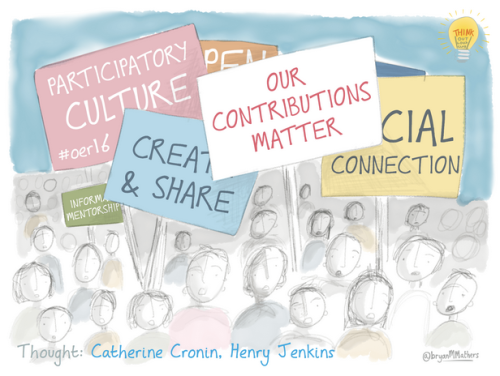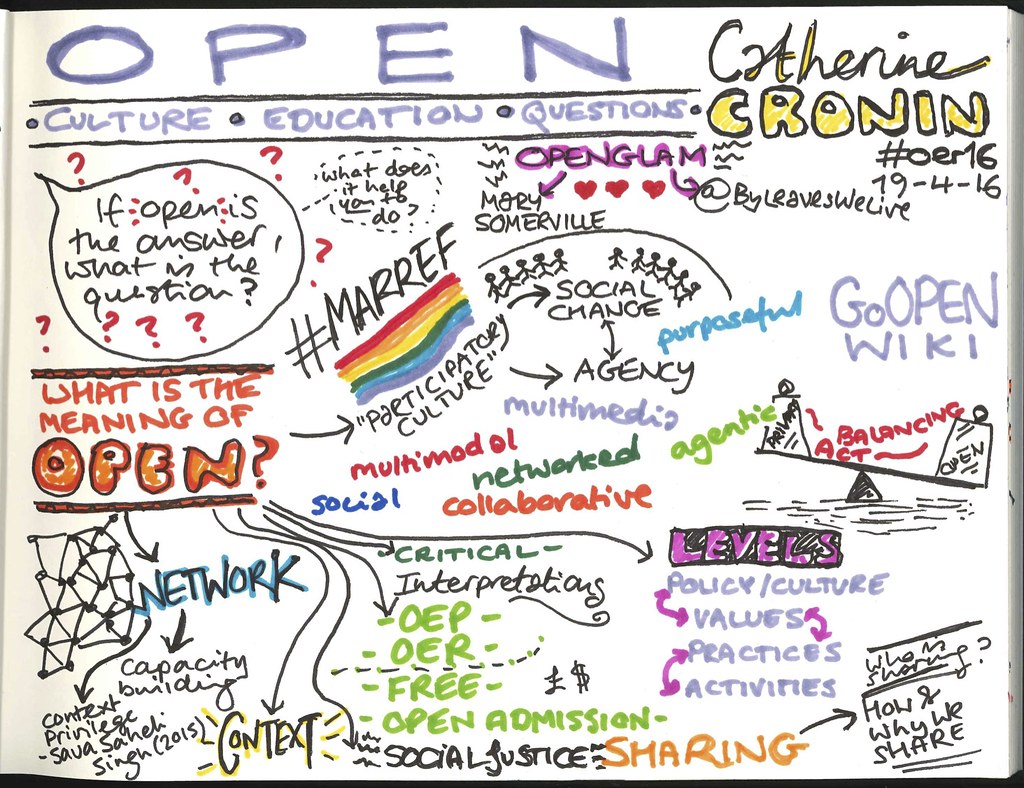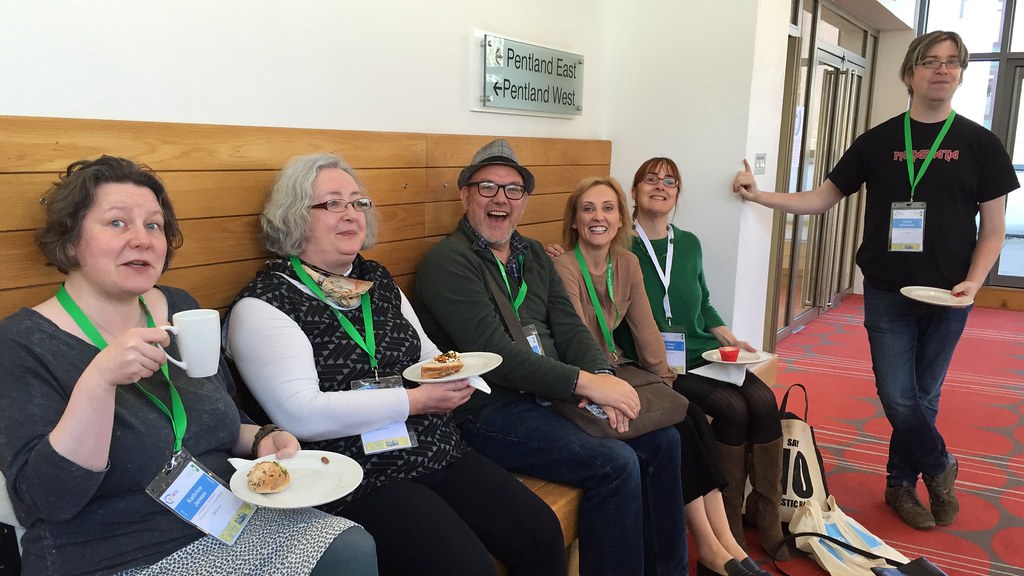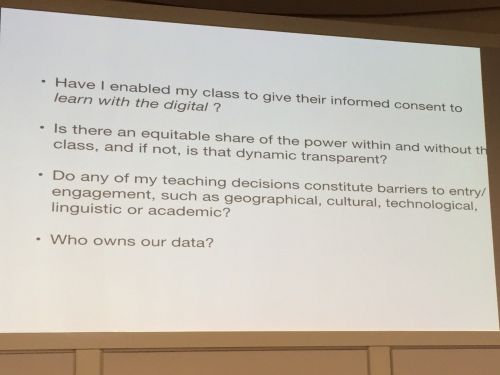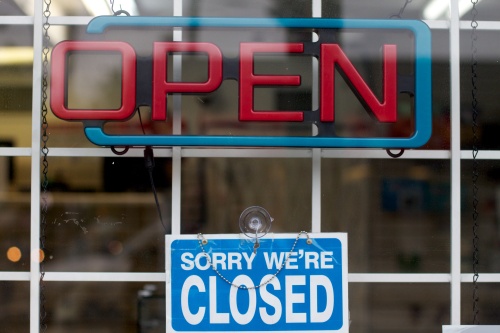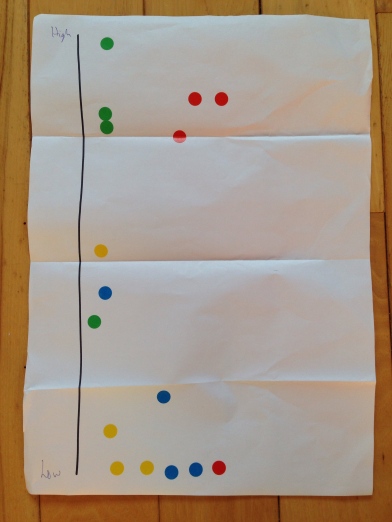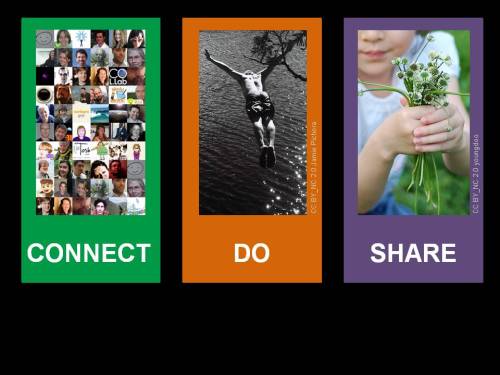I’m currently in the early stages of Ph.D. research on digital identity practices in open education. I’ll be exploring how educators and students in higher education construct and negotiate their identities — social, pedagogical, civic, professional — in open online spaces in which they interact. Some of the questions I am considering are: How are digital identities enacted in open vs. bounded online spaces? What is the relationship between digital and embodied identities, particularly with respect to learning and teaching? And how are power relationships between educators and students negotiated in different online spaces?
Last week I was invited to give a seminar on this research (early stages!) as part of the IT research seminar series at NUI Galway. Below are the slides, a brief summary of my research, and a reflection on my own identity as a “digital identity” researcher.
ccc
The recently published Horizon Report 2014 (Higher Education edition) is just the most recent of many to pose the question: How will formal learning institutions remain relevant when quality learning materials are freely available? (i.e. now). Of course, it isn’t just learning materials, but learning networks and learning experiences that are freely available in our increasingly networked society. The MOOC phenomenon is just one example: across the spectrum of MOOCs, from open, connectivist models to more content-focused, behaviourist/cognitivist models, the desire for flexible, autonomous learning is clear. Noisy pronouncements to the contrary, open education is about much more than MOOCs, of course. Open education includes initiatives and practices such as the use and creation of open educational resources (OERs); open course blogs, websites and wikis; open sharing of student work — via a range of digital, mobile and social media; and open communication across learning networks using social media and social networking tools.
identities & learning spaces
In most higher education institutions, after meeting stated entry criteria, student access is achieved by fee and by name. In my university, for example, students must register using the name shown on their birth certificate, unless this has been legally changed. Thus, in most classrooms and within most Learning Management Systems, students and educators are identified by their real names. To participate in open online education, however, learners need simply the will to participate and an identity. Learners not only choose their own learning paths, but they create their own digital identities. Thus individuals can choose to be identified by their name or a pseudonym, by a photo or an avatar, with a consistent digital identity across multiple networks or different digital identities for different situations and contexts.
So how does the concept of digital identity layer on to our understanding of offline or embodied identity? Identity can be defined as a constantly re-worked personal narrative; we continually create and develop our identities through our actions and our interactions with others. But identity is not a single construct; we have multiple identities related to our different roles and contexts (e.g. daughter, mother, partner, friend, student, lecturer). This is the case for both digital and embodied identities, as Miller makes clear in the excellent Future Identities report of 2013, which explores the relationship between online and offline identities:
As studies become more contextualised it seems that the real lesson of online identity is not that it transforms identity but that it makes us more aware that offline identity was already more multiple, culturally contingent and contextual than we had appreciated.
Miller also notes that contrary to many media claims, most studies (with the exception of a few, e.g. Turkle) oppose the notion of digital dualism, i.e. the belief that online identities are separate from and less authentic than our offline identities. Our online and embodied identities are, in fact, deeply intertwined.
Learning involves identity transformation. In Lave and Wenger’s Community of Practice work, for example, education is defined as an identity project: there is a relationship between “learning to do” and “learning to be”. During the course of their learning, students in higher education develop new identities: personal, social, academic, professional. Both students and educators develop and enact their identities when interacting in learning spaces, be they physical or digital, bounded or open. As part of my study, I’ll be exploring three types of learning spaces: physical classrooms, bounded online spaces (e.g. members-only LMSs), and open online spaces or networked publics (e.g. blogs, wikis, discussion forums, social networking sites). These three modalities are often used in combination with one another, but my study aims to identify the specific affordances of each, particularly with respect to identity, access and equity.
The first two of these spaces, classrooms and LMSs, are private learning spaces in which learners and educators within a particular course can meet, physically or virtually, to interact and learn together. In the third category, open online spaces, educators and students in a given course can interact with one another as well as with other students, educators, writers, creators, experts, etc. in other courses, disciplines, institutions, organisations or locations.
politics, power & privilege
Politics, power and privilege cannot be ignored in educational research. For example, in examining learning spaces, the architecture of most physical classrooms speaks loudly about power and privilege. Who is present, and who is not? Who sits and who stands? Who moves? Who speaks? Where is attention focused? Answers to these questions reveal whose voice counts, whose knowledge counts. Those educators committed to democratic practices — to creating environments for mutual knowledge construction and sharing — often must work against the constraints of the architecture of physical classrooms.
In bounded online spaces, such as members-only LMSs, system architectures may communicate similar messages. LMS participants are typically identified by their (real) names and their roles — student, lecturer, tutor, observer, etc. Lecturers and tutors have design, creation and editing privileges within LMSs; students usually have fewer and lesser privileges (e.g. writer vs. editor). These are signals about power and ownership of the learning process.
In open online spaces, students and educators are not limited by real-name identities, nor by rigid role definitions. Students, particularly, may experiment with new identities – not just social identities, with which they may have some confidence, but learner identities and public/civic identities. The teacher-student relationship is changed, moving beyond a teacher-student dichotomy. Students and educators can have more equal roles in creating content, sharing resources, participating in and starting conversations. Educators can be learning peers in open online spaces, not just the lecturer at the head of the classroom or with privileges within the LMS. Although the technologies themselves do not create democratic environments, educators who choose to engage with students in open online spaces, who use open tools, and who engage in and model democratic practices, can foster learner autonomy and agency.
Open online spaces can be considered what Gutiérrez defines as a Third Space of learning; where students develop sociocritical literacies not in a formal learning space, or informal learning space, but a combined space:
People live their lives and learn across multiple settings, and this holds true not only across the span of our lives but also across and within the institutions and communities they inhabit – even classrooms, for example. I take an approach that urges me to consider the significant overlap across these boundaries as people, tools, and practices travel through different and even contradictory contexts and activities.
Many students already have confident social identities online, but developing identities as learners, writers, scholars, citizens — these are important tasks as part of higher education. As Etienne Wenger has noted:
If institutions of learning are going to help learners with the real challenges they face… [they] will have to shift their focus from imparting curriculum to supporting the negotiation of productive identities through landscapes of practices.
Moving beyond private, bounded learning spaces into open learning spaces, even occasionally, provides learners and educators with opportunities to discuss and develop important digital and network literacies, as well as a deeper awareness of issues such as privacy and data ownership. Open practices allow students the potential to link formal education with their informal interests, knowledge and expertise, and to build Personal Learning Networks which reflect all of these – to the extent that they wish to do this. In these open Third Spaces of learning, learners cannot just develop new identities, but strengthen existing identities, and integrate identities across multiple settings and contexts.
postscript: my own identities
During the past few months, I’ve added this ‘digital identities’ research project to a full schedule of teaching, programme management, and my own networked learning and blogging activities. It’s been challenging, but mostly satisfying. Those cycles that people warned me about when embarking on the Ph.D. ( lurching from “wow, this is wonderful!” to “oh, I’m lost!”, and back again) — I reckon I’ve ridden through a few of them already 🙂
At the start, it was the practical aspects of combining these activities that demanded my energies. How will I organise my schedule/workspace/systems to accommodate my new research commitments? And how will I manage others’ expectations of me — colleagues, students, family, friends? Lots of thinking, discussion, negotiation of boundaries.
But, of course, it’s not *that* simple. It’s not just my schedule that must be negotiated, but my own identities. Every day the balance is slightly different: dividing my hours and energies between teaching, student and facilitator support, programme management, learning and research. For the past few years, this blog has provided an invaluable space for sharing ideas and questions related to learning and teaching, for thinking-through by writing, and for connecting. Up to this point, I’ve been happy to share my learning and to share my teaching experiences. So where does “researcher me” fit?
For example, I’ve been working with Jane Davis and Joyce Seitzinger over the past 6 months, each of us writing papers and collaborating on a joint symposium for the upcoming Networked Learning conference. Throughout all of that research and writing and rewriting, I didn’t write here in my blog. I put my time and effort into writing the paper (in the “academic” voice) and engaging in discussions with Joyce and Jane. That time was productive, and it wasn’t my intention to separate these two activities — research and blogging — but that’s what has happened. Hmmm…
As so often happens, via my PLN I read a recent blog post by Bonnie Stewart in which she described this dilemma: identity challenges for hybrid scholars:
I’ve been researching hybrid scholars – people like me who are both cultivating some semblance of a traditional institutional academic identity and building connections and credibility for their ideas in online networks … I’ve been trying to be both networked scholar and proper academic, whatever that is. I’ve been trying to wear two entirely separate hats and engage in two entirely separate identity economies … If there’s anything to the premise that the potential of massiveness + openness = new literacies of participation, it’s those of us out here straddling the edges of old and new that will end up making and modelling those literacies, whatever they turn out to be worth.
Michael Gallagher, another valued member of my learning network, posted a comment to Bonnie’s post which captured this conundrum — and my perspective — so well:
My identities have oscillated all over the place depending on where the projects reside (scholar one day, project manager the next, teacher the following, that sort of thing). I find a certain joy in that disequilibrium, as if I dance between these ambiguous spaces and identities long enough, something new will emerge. And it will just emerge, as you said, by walking the road. And if I contribute at all, it will be through my blog and that emergent identity.
As I noted in my response to Bonnie’s post, I’m often comfortable in boundary and hybrid spaces — I’m a New Yorker living in Ireland, a feminist working in technology, an engineer doing research in education, and I’ve taught/teach in both higher education and community spaces. So being a hybrid scholar feels right — most of the time. Most of the time, the intersections energise me and spark connections which move my thinking and practice. But sometimes things feel out of balance, and I suppose that’s what I’ve recognised regarding my writing at the moment.
So, where am I now? I’m enthusiastically continuing my research and also reflecting on my identity as a hybrid scholar. This reflexivity seems important, given the nature of my research. I am comfortable as an open and networked learner and educator, and still in a liminal space as an open researcher. This blog post is another step in developing that identity, and opening myself to new creative possibilities. As Michael Gallagher expressed in his beautifully written blog post ideas and identities in liminality, creativity springs from ambiguous states; liminality is a “generative state of being”.
If you identify as a hybrid scholar, an open educator, a researcher in the area of open education, networked learning and/or digital identities, how do you navigate these hybrid spaces? I’d love to hear your thoughts, and to learn more about your work. 🙂



